Wednesday, May 5th 2021

GIGABYTE Outs M28U 4K Gaming Monitor with Integrated KVM
GIGABYTE released the M28U, a unique 28-inch 4K Ultra HD gaming monitor that comes with an integrated KVM feature. This lets you effectively switch between two PCs. Simply plug the PCs to the monitor's multiple display inputs; plug your keyboard, mouse, and USB headset to the monitor's downstream USB ports, and the monitor's two upstream USB connections to the two PCs (one of these is a USB-C). Switching between the two is as easy as pressing a button on the monitor. This will prove particularly useful if you have a personal desktop and a company laptop to use in your home office, and don't want to clutter the place or waste time plugging things in and out.
As a display, the M28U is no slouch, its 4K Ultra HD (3840 x 2160 pixels) IPS panel supports refresh rates of up to 144 Hz, 178°/178° viewing-angles, 300 cd/m² maximum brightness, DisplayHDR 400, and 1000:1 static contrast ratio. Display inputs include two HDMI 2.1, one DisplayPort 1.4, and USB-C. From these, the USB-C input supports not just USB for the second PC's input, but also DisplayPort passthrough. If your second PC lacks an all-powerful USB-C, simply use any other display input, the USB-C will only take in upstream USB (which you can adapt to a type-A USB 3.0 port). The downstream USB hub puts out three 5 Gbps USB 3.0 ports. The company didn't reveal pricing.
As a display, the M28U is no slouch, its 4K Ultra HD (3840 x 2160 pixels) IPS panel supports refresh rates of up to 144 Hz, 178°/178° viewing-angles, 300 cd/m² maximum brightness, DisplayHDR 400, and 1000:1 static contrast ratio. Display inputs include two HDMI 2.1, one DisplayPort 1.4, and USB-C. From these, the USB-C input supports not just USB for the second PC's input, but also DisplayPort passthrough. If your second PC lacks an all-powerful USB-C, simply use any other display input, the USB-C will only take in upstream USB (which you can adapt to a type-A USB 3.0 port). The downstream USB hub puts out three 5 Gbps USB 3.0 ports. The company didn't reveal pricing.
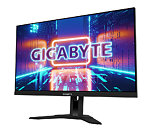
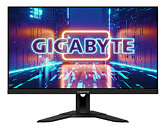
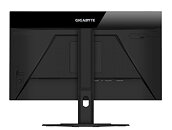
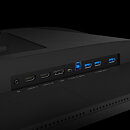
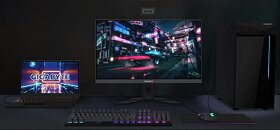
13 Comments on GIGABYTE Outs M28U 4K Gaming Monitor with Integrated KVM
24h.pchome.com.tw/prod/DSABHU-A900BA3LI?fq=/S/DSABHU
I really need a 32" screen and 3.5mm headphone and microphone jacks and switching them at the same time. That would be awesome, especially if the KVM part was one button.!
As it is currently, I have to hit a few buttons on the screen, press one button for the keyboard/mouse (KVM switch with no video), unplug my headphones (on extension and plug them into another extension to go to my second PC).
This is a good start, but not quite there yet.
KVMA switches have been around for some time that use 1x 3.5mm jack for headphones/speakers, it would not be difficult (or costly) for them to add in a pair of 3.5mm jacks and make it into a KVMAM (Keyboard, Video, Mouse, Audio, Microphone) switch, and if they have already built in the functionality of this being a KVMA switch via USB headphones/headset this would round out the package for virtually all potential users interested in this, which I am, apart from this missing (simple) functionality and that this screen is too small for my liking, but I expect them to offer this in other screen sizes.
Either Gigabyte or another manufacturer will come to market with something that fills this gap in the market as not everyone wants to use USB headsets / speakers / microphones, or wants to spend the money on replacing their existing ones.
As for KVMA already being there, this is not really true. It has usb switching. Anything usb will (likely, I'm assuming this isn't the old-school KVM that only supported keyboards and mice) switch, as it all runs over a single uplink, regardless of what the device on the end is. Passing through and switching analog audio would require at the very least two more switchable input pairs on the controller chip plus an extra output pair, as well as engineering to ensure that those lines don't get hammered with interference. That's anything but trivial.
As for the "Audio" switch, many KVMA switches (when they were all PS/2 / VGA) essentially threw in the Audio switch component for free, if this is overly complex or expensive to do in 2021, then manufacturing technology has taken a step back.
You also clearly misunderstood what I meant by "USB switching". This is a monitor with a built-in USB hub. It also is advertised with KVM functionality. That likely means that the USB hub - in its totality, not just for keyboard/mouse functions - is muxed between different host devices through the USB-C and USB-B connectors. This is different from traditional KVM, which typically only supports keyboard and mouse signals through any USB ports present. It would be really weird if this supported old-school KVM with only the connected keyboards and mice switching over. If it supports switching of any connected USB device, then it's a USB switch, not just a KVM switch.
As for audio, the monitor has a headphone output. This is derived from a DAC getting a signal from the DP and HDMI connections. It has no connection to the motherboard's audio jacks whatsoever. So, for it to gain the functionality you're asking for would require at least two new inputs (though ideally four, for audio + mic across two devices), as well as the switching chip to not just be a mux of two separate USB uplinks, but also switching between two sets of audio lanes. I never said it was overly complex or expensive, I said it was an unnecessary expense targeting a tiny niche among the already small niche of people interested in a gaming monitor with KVM functionality, and that it would add complexity to the design and featureset of the monitor. It would also make for a hellishly messy I/O. And, again, it would likely add a ton of noise to the audio signals, as they would need to pass through some very RF-dense areas.
Regarding old KVM switches throwing in audio for free - sure, but those were already a mess of cables already, and not at all targeting a market like this. They were the furthest thing from single-cable docking you'd find, pretty much. (In my experience they were also terrible in terms of adding hum and buzzing to your audio.) Again, you're seeing this from the angle of what you want, not what it's targeted at. Of course you can complain that it doesn't fit your needs, but your needs are clearly quite specialized in this case. That's life, sadly.
And, again, what you're asking for is fundamentally incompatible with the core concept here, which is single-cable USB-C docking of secondary devices. If you're not fine with DP/HDMI-transmitted audio (or using a separate solution for this), then this clearly isn't the product for you.